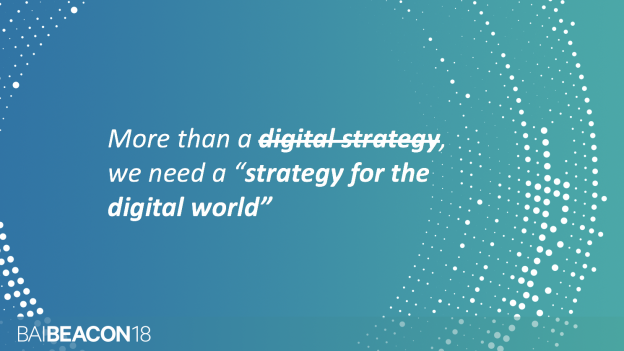It was a privilege to speak at the BAI Beacon conference in Orlando a few weeks ago. The topic of the day was digital (of course) and what banks should be doing to improve customer experience and make operations more efficient.
My session was on “creating connected customer journeys of the future” – based on my book Connected! I felt that even as we all examine the more immediate need to launch new digital capabilities such as mobile, analytics & AI, there had to be a longer term view of what the overall landscape of customer engagement looks like. So in this session tailored for banking I linked the need for these immediate capabilities to that future vision – how can we build a customer engagement powerhouse to by looking at our customers as people, instead of just account holders? How can banks be the center point of customer interactions, orchestrating instead of just providing the money rails?
Given the significant presence of community banks and credit unions, this need was even more prominent. The trust and strong customer relationships were front and center, but the roadmap to enhance those, and to maintain key business metrics almost always came down to technology upgrade imperatives. Technology drives everything today so it wasn’t a surprise. But I didn’t want to make this vision dependent on large technology investments.
So, here’s how we (the audience and I) analyzed this important topic.
- First we looked at all the top priorities facing us today and so much in the vogue – all of the new digital stuff we need to do such as analytics, AI, mobile etc. For the lack of a better term I called it the “inside-out” plan.
- Then we looked at what “outside-in” is and it turns out that’s the top down strategy making – looking at product portfolio evolution, branch network optimization, customer satisfaction, distribution etc.
- But something was missing. We realized that both of these views did not cater to the tremendous disruption we are seeing in the marketplace today. Could both these views help counter the expanding ambitions of new entrants into the banking sector, and changing customer preferences that go beyond a better mousetrap?
- Turns out there is a key ingredient that needs to be added in to make this work – connected customer journeys. There’s a big difference in mindset between traditional and new businesses (or born online companies). The difference is that the new entrants we are worried about don’t have a mindset of core domain competency. E.g. define Amazon’s business, or Google’s, or Facebook’s. And that’s forcing everyone to re-examine their own models, e.g PayPal, Apple, WalMart, Uber, Marriott etc.
- So, to get out of the trap of domain competency, we needed to focus on what’s important – the customer and what they want, not how we want to serve them. It follows that our product and service portfolio must expand, and the most optimal way for a traditional business (e.g. banking) to expand its product portfolio that maps to the customers is not to become a new business but to become a networked organization – complementing it’s portfolio with those of other companies. In short, we needed to think about building the right ecosystem.
- Then, we looked at what it might take to do this. For example, we saw that we did not have an underlying connecting thread that integrates customer interactions across industries that are enabled by the bank but not orchestrated by the bank – financial advice, retail, restaurants, hotels, recreational activities and so on. This business ecosystem structure led us to focus on the purpose of our business – to improve our customers’ financial well being and make life easier for them – rather than getting trapped in the narrow identity defined by our products. We discussed a few examples of how this is being done slowly but surely in banking. We also saw that big banks with deep pockets are not the only ones doing the innovative stuff. And we looked at the analogy of how ecosystems have evolved from small stores to superstores to online conglomerates and now towards a network of businesses.
- Finally with this ecosystem structure and examples in mind, we put a new lens of connected customer journeys on the roadmap of building digital capabilities. For example, what should be in a mobile app for the bank, or what additional considerations must a core system upgrade look at, and how can the conversation of branch network optimization be given a new perspective. And while we were at it, I could not resist a primer on blockchain/DLT which is of course what I do now. As we went through the primer, the concept of an ecosystem operator surfaced which is – surprise – the bank!
It is unlikely that this ecosystem or connected customer journeys based structure will take center-stage in day to day business operations in the short term. But I would like to think it provided a very useful model to evaluate and shape investment strategies, partnership discussions, and execution roadmaps for the medium to long term. More importantly, I hope it helped augment in a tangible way the concept of what it takes to be a customer centric business, and the associated slogans that go with it. Last but not the least, thanks to BAI for seeding the beginnings of some great friendships with emerging leaders who will define what 2.0 looks like!
PS:
- Refer to the Customer Interaction Index to see the difference between businesses that have a sticky relationship versus that don’t.
- You can download the summary eBook here to review all of the 5 building blocks including 3-Tier loyalty and CX focused org design

